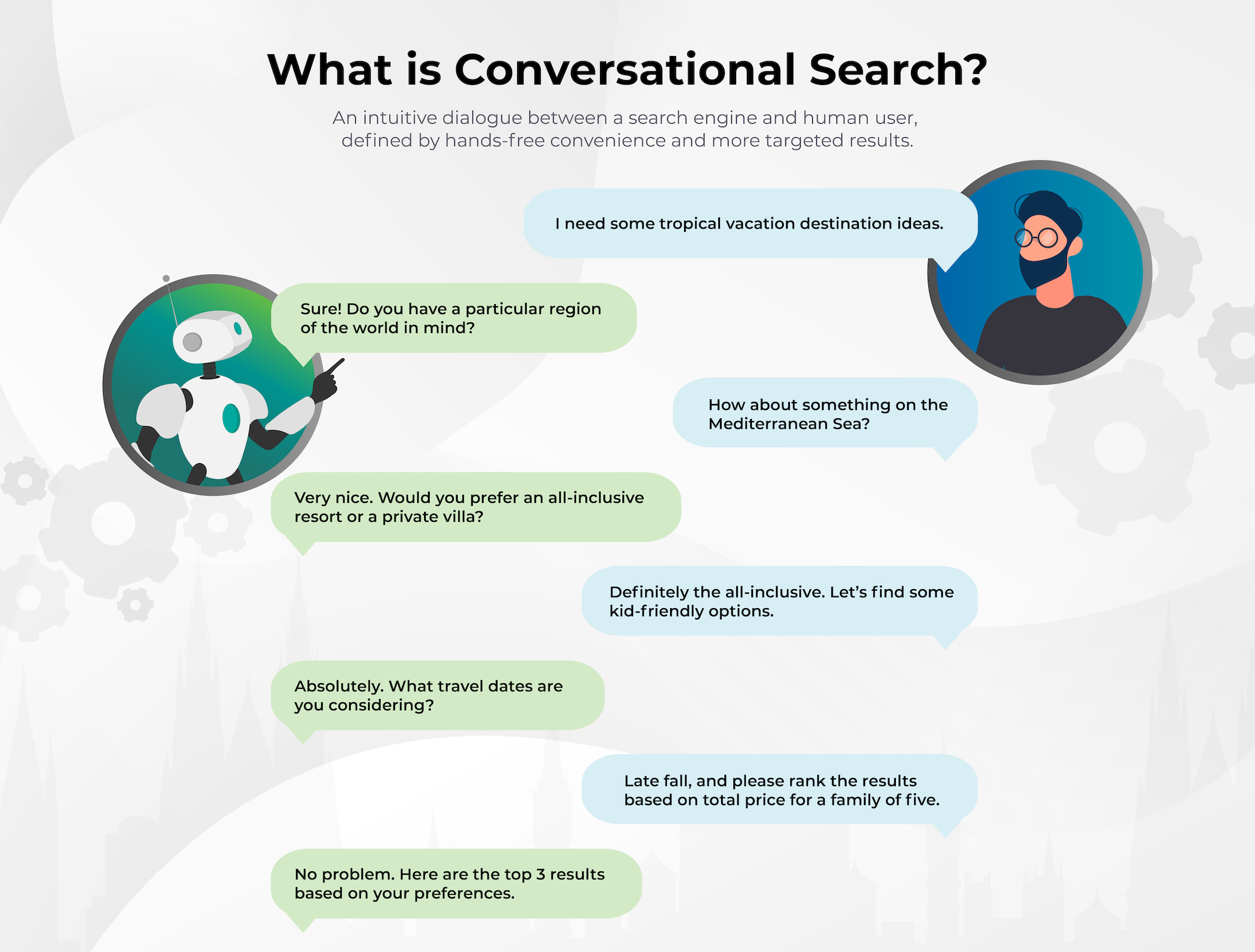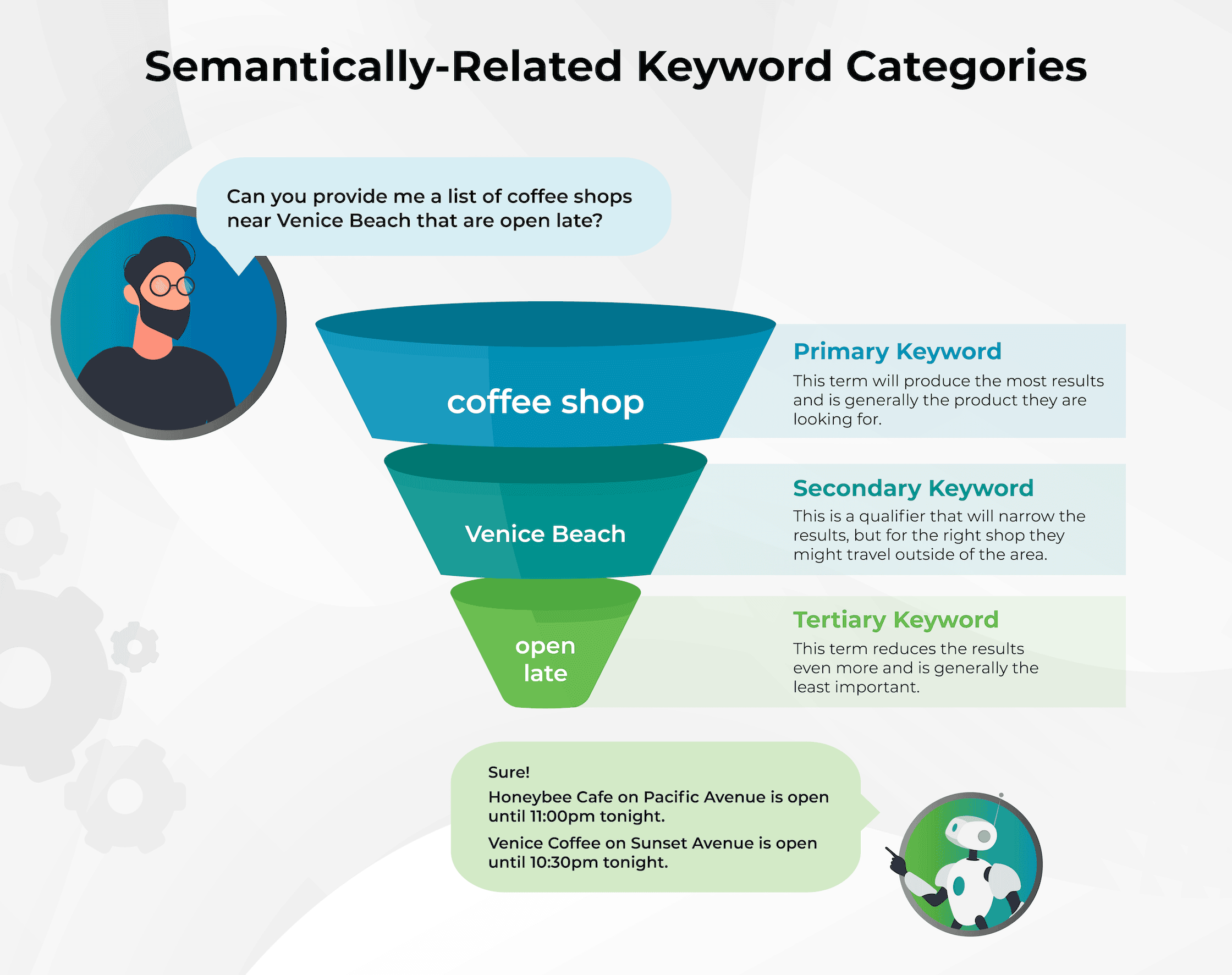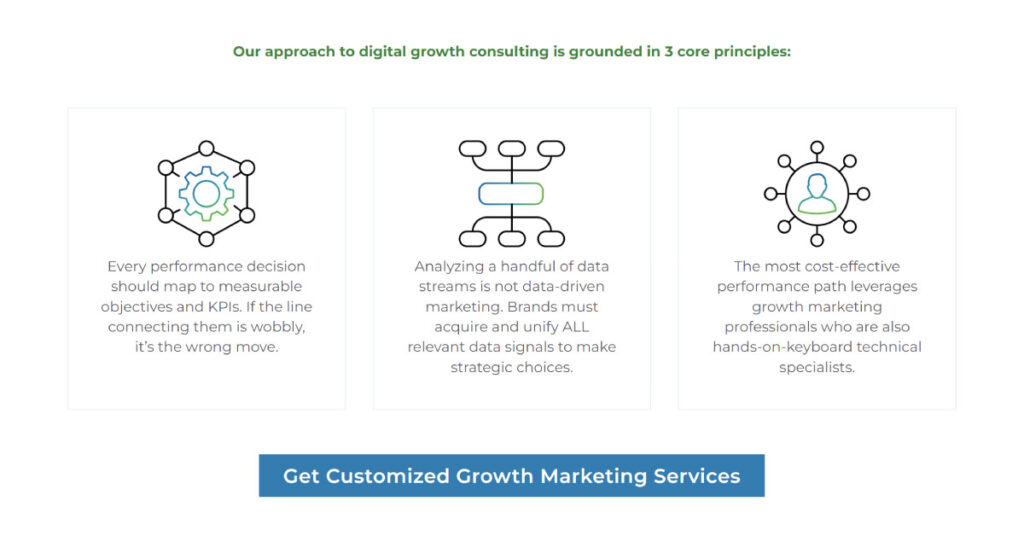
High-performance growth marketing requires keeping your eye on fluctuating user behavior, which is why conversational search is something more brand leaders should be examining.
Search trends show conversational search (not the same thing as voice search, by the way – we’ll clarify below) is already commanding a meaningful share of search queries, and is only expected to grow.
And we’re not just talking about using your voice as the input for searches in your smartphone. Conversational search is happening through a broad range of device types, including:
- Smart watches and other wearables
- Smart speakers
- In-car systems
- Smart home appliances like your fridge, thermostat, home security system, etc.
- Virtual reality and augmented reality wearables
- Gaming consoles like Xbox and PlayStation
To help you understand conversational search, its implications for your existing SEO strategy, and more, let’s unpack:
- What is conversational search?
- What is the difference between conversational search and voice search?
- What are the benefits of conversational search?
- 5 reasons brands can’t afford to ignore conversational search
- How to navigate the challenges of implementing a conversational search strategy
- 4 questions brands should ask to begin optimizing for conversational search
What is conversational search?
Let’s pretend you just looked at the calendar and realized it’s been ages since you took a family vacation. The horror. So you whip out your phone and start talking. What follows sounds like this:

What you’ve just witnessed is conversational search in action. And no, this is not some idealistic internet of the future. This is a sizable segment of search queries that has been growing steadily for quite some time.
76%
of voice search users search on smart speakers for local businesses at least once a week, with the majority doing so daily.
Source: BrightLocal
Conversational search facilitates a dialogue between the search engine and the user, with the goal of providing hands-free convenience and more targeted search results.
The AI can understand search intent, search context, and if needed, will clarify the user’s expectations through an exchange that closely resembles a human conversation.
So how does conversational search work?
Conversational search is powered by natural language processing technologies (NLP), a specialized arm of AI. The primary objective of NLP is to improve machines’ ability to comprehend, analyze, and respond to humans through natural language.
Simply put, NLP aims to help machines and humans communicate more effectively.
Key features of conversational search
1. Natural Language Understanding – It understands complex statements and questions, even when delivered via informal language structures and colloquialisms.
2. Context Awareness – It can engage with layers of follow-up queries related to previous interactions, to provide more relevant responses based on the context the user provides.
3. Interactive Search Experience – Rather than a ‘one and done’ search experience, it supports a back-and-forth exchange that mimics a human-to-human conversation. These dynamic dialogues help to:
- humanize the interaction
- provide the convenience of a hands-free search experience
- make the user’s search intent even clearer so that search results are more precise and highly relevant.
What is the difference between conversational search and voice search?
While these terms have a lot in common and are mostly used interchangeably, to be super technical about it, conversational search and voice search are not the same thing.

Voice Search: Using voice as the input method for a search.

Conversational Search: Using voice as the input method for a search experience that prioritizes a dynamic, human-like interaction between the user and the AI assistant.
Simply using your voice for a search doesn’t automatically make that a conversational search experience.
Using your voice for a search that lacks contextual analysis and machine-to-human dialogue (the core elements of conversational search) is a voice search, not conversational search.
What are the benefits of conversational search? 5 reasons brands need to pay attention.
REMINDER: Marketing leaders can sometimes become so myopically-focused on individual and team KPIs that they lose sight of the holy grail of marketing: user experience.
Growing numbers of users prefer a search experience defined by conversational search.
And whatever the user likes, we need to understand and leverage like our business depends on it – because it does.

1. Accessibility
‘Cognitive switching penalty’ is a psychological term that refers to the mental weight of switching between tasks and contexts. Mental fatigue, reduced productivity, and increased errors, are some of the primary outcomes of this switching penalty.
When humans have to switch drastically between how they interact with other people vs machines, there’s a cognitive switching penalty to be paid. This taxes our brains in a way that us comfort-loving humans would prefer to avoid.
Conversational search makes the interaction between humans and machines resemble human-to-human interactions, which lessens/removes the cognitive switching penalty effect.
Rather than adopting formal or stilted “computer-speak” (requiring switching context from how we naturally speak), conversational search lets us continue using the everyday language we’re most comfortable with. This makes conversational search technology more accessible and inviting.
Conversational search has particular appeal for people with disabilities. For example, people with vision impairments or difficulty using traditional input devices, can have greater success engaging with organic search using voice and conversational search.

Conversational search has particular appeal for people with disabilities. For example, people with vision impairments or difficulty using traditional input devices, can have greater success engaging with organic search using voice and conversational search.
2. Contextual Understanding
Imagine you had a conversation over coffee with a friend last week. Two days later, you had a short exchange about the same subject over text, and tonight, you’re meeting them for dinner and expect the same topic to come up again.
In each of those interactions, layers of contextual understanding are created between you two. Implicit details are communicated. Effective communication is an exercise in building blocks.
Conversational search systems understand and store contextual understanding across multiple search interactions, just like you and your friend did in that hypothetical scenario above.
The AI assistant’s ability to retain and navigate information from previous interactions results in deeper understanding and the delivery of more accurate and relevant search results.
3. Speed and Ease of Use
You know that frustrated feeling when you search for something and the results are way off, so you start over with a new search term and hope that one works? That happens because the machine isn’t understanding your search context and intent yet.
With its natural language and context-understanding capabilities, conversational search can skip over that “We don’t understand each other!” irritation.
It quickly grasps search intent (or if clarification is needed, can conduct that process quickly via voice interactions), delivering the information users want in less time.
4. Personalization
Because conversational systems can recall previous interactions with the user, this heightened contextual understanding gives the machine a more holistic view of the user’s preferences.
This capacity offers particular utility for eCommerce brands seeking to increase ATV and LTV by providing highly personalized recommendations that engage the user, drive sales, and support loyalty.
Rethinking the Marketing Funnel: How Google and Meta Ruined the Top of the Funnel
Google and Meta ruined the top of the funnel. Understand what’s changed and learn new strategies for reaching potential customers.
5. Greater Engagement. Greater Insights.
Thanks to the increased engagement and personalization insights that conversational search provides, it represents a potent opportunity for brand leaders and growth marketers.
The most valuable marketing insights are those that help you better understand your ideal customer’s preferences and behavior – these are exactly the insights that conversational search provides.
Savvy brands should be using this data to refine their offerings, adjust marketing strategies, elevate content marketing efforts, and streamline every single customer touchpoint.
Content Marketing Services and Strategy
Drive audience growth and engagement with expert content marketing services featuring custom strategies, data-driven insights, and measurable results.
How can brands navigate the challenges of implementing a conversational search strategy?
Maybe the biggest challenge that conversational search marketers face is that how humans speak is incredibly varied. Just a few of the most common voice-impacting factors are:
- Regional accents and jargon
- Non-native English speakers
- Speech impediments
- Variations in syntax
- Use of code switching
- Variations in input phrasing (“best bakery in Austin” vs “Sarah’s birthday party is this Saturday. I need a last-minute chocolate cake delivered to Bee Cave before noon. And if you can find one that’s gluten-free, that’s even better.”
People speak differently for a number of reasons, so conversational search success often depends on building a larger network of content that gives the machine ample semantic relevance so it can understand if/how your content addresses the user’s needs.
If you want to be perceived as an industry thought leader (by your target audience and by the search platforms they use), you need a content library that supports your authority on multiple platforms.
4 questions brands should ask to begin optimizing for conversational search
1. When was the last time you revisited your keyword research?
Too many brands do a keyword exercise once and call it a day. Keyword research is a regular exercise for the most competitive brands.
Search phrasing, keywords, and/or the contextual placement of those keywords is not static. Brands need to routinely refresh their keyword research to understand what questions are being asked, how users are communicating their search query, and if/how those things are changing over time.
2. What are the top 4-6 categories that emerge from your keyword research?
Plopping the same few keywords on every page on your site is not an organic search strategy – not one that intends to perform well.
Thorough keyword research will reveal several keyword categories that map to your product/service. These categories are the starting point for semantically-related content that needs to be created or optimized, if some of it already exists.

3. Is your content up to standard?
This one might sting, especially if your last few budgets included large line items for content. Unfortunately, content marketing quality continues to be one of the biggest challenges many brands are facing.
Audit your content (this will likely require engaging an outside partner who can be objective) for strategic gaps, keyword integration, semantic variance, and search performance.
4. When was the last time your website got a technical checkup?
Putting quality content on a website with failing technical health is like slamming the door in every search engine’s face.
Regular technical SEO checks will find and fix any problems with search crawlability, indexability, page load time, Core Web Vitals scoring, meta tags, canonical tags, mobile responsiveness, and more.
Summary of Conversational Search
- Conversational search lets users interact with search engines in a way that resembles a natural human conversation.
- The last estimate released from Google stated that voice-driven search accounts for roughly 20% of all mobile searches.
- Using natural language processing (NLP) technologies, conversational search retains relevant information from previous interactions and understands the search context and user intent with a greater degree of precision than traditional searches.
- Brands seeking to generate visibility in conversational searches need to:
- Revisit keyword research
- Identify 4-6 keyword categories that function as a map for semantically-related content creation
- Create a larger library of high-quality content that aligns all keyword categories to your product/service
- Conduct regular Technical SEO checks to confirm the health of your website.






